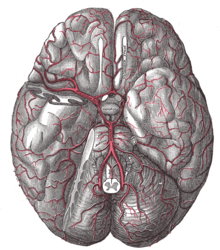Posterior cerebral artery
The arteria cerebri posterior ( Latin for ' posterior cerebral artery ', also abbreviated PCA from English posterior cerebral artery ), in animals referred to as the arteria cerebri caudalis , is one of the three main arterial vessels of the brain . It arises from the division of the unpaired basilar artery in the circulus arteriosus cerebri and forms an anastomosis with the arteria cerebri media on both sides , the arteria communicans posterior .
In the posterior cerebral artery, a distinction is made between segments P1 to P4:
- P1: The precommunicating segment runs through the interpeduncular cistern .
- P2: The post- communicative segment runs through the cisterna ambiens .
- P3: quadrigeminal segment
- P4: terminal segment
Coverage area
The posterior cerebral artery runs behind the diencephalon and supplies the occipital lobe , the basal surface of the temporal lobe , the hippocampus , the thalamus , the rear portions of the hypothalamus and the wire netting of the lateral ventricles .
Failure symptoms
The occlusion of the posterior cerebral artery typically leads to the loss of the visual field on the opposite side ( homonymous hemianopia ). The bilateral obliteration of the posterior cerebral artery leads to cortical blindness . A very deep, bilateral obstruction ( basilar tip syndrome ) also results in a bi- thalamic infarction with impaired consciousness .
See also
Web links
Individual evidence
- ↑ FCAT - Federative Committee on Anatomical Terminology: Terminologia Anatomica. Thieme, Stuttgart et al. 1998, ISBN 3-13-114361-4 .

